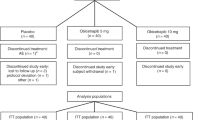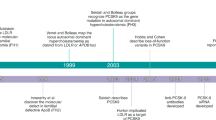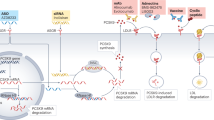Abstract
Epidemiologic data from the Framingham and Prospective Cardiovascular Munster studies, demonstrating an inverse correlation between the plasma concentration of HDLs and the incidence of cardiovascular disease, have driven research to explore precisely how HDLs confer this cardioprotective effect. HDLs are anti-inflammatory, antithrombogenic and have vasoactive effects, as well as being efficient cholesterol acceptors enabling the removal of cholesterol from peripheral tissues, all functions that are likely to protect the vasculature. The first part of this article will review the clinical evidence in support of the pleiotropic effects of HDLs, along with laboratory-based investigations of the molecular mechanisms of action. As the evidence of clinical benefits of raising plasma HDL concentration has increased, so has the number of strategies currently being considered to achieve this goal. The second part of this article will review three current strategies: infusion of HDL-like products, comparing physicopharmacologic characteristics of the two commercial products currently under trial; the use of fibrates to raise plasma HDLs (although fibrates primarily reduce triglyceride levels, certain derivatives are able to induce significant increases in plasma HDLs); and the use of drugs that inhibit cholesterol ester transfer protein (these drugs increase plasma HDL concentration either alone or as an adjunct therapy with statins). The clinical efficacy and mechanism of action of fibrates and inhibitors of cholesterol ester transfer protein will be reviewed.
This is a preview of subscription content, access via your institution
Access options
Subscribe to this journal
Receive 12 print issues and online access
$209.00 per year
only $17.42 per issue
Buy this article
- Purchase on Springer Link
- Instant access to full article PDF
Prices may be subject to local taxes which are calculated during checkout
Similar content being viewed by others
References
Wang M and Briggs MR (2004) HDL: The Metabolism, Function and Therapeutic Importance. Chem Rev 104: 119–137
Gordon DH and Rifkind BM (1989) High-density lipoprotein: the clinical implications of recent studies. N Engl J Med 321: 1311–1316
Assmann G and Schulte H (1992) Relation of high-density lipoprotein cholesterol and triglycerides to incidence of atherosclerotic coronary artery disease (the PROCAM experience). Protective Cardiovascular Munster Study. Am J Cardiol 70: 733–737
Walsh A et al. (1989) High Levels of Human Apolipoprotein A-I in Transgenic Mice Result in Increased Plasma Levels of Small High Density Lipoprotein (HDL) Particles Comparable to Human HDL3 . J Biol Chem 264: 6488–6494
Rubin EM et al. (1991) Inhibition of early atherogenesis in transgenic mice by human apolipoprotein A-I. Nature 353: 265–267
Plump AS et al. (1994) Human apolipoprotein A-I gene expression increases high density lipoprotein and suppresses atherosclerosis in the apolipoprotein E-deficient mouse. Proc Natl Acad Sci USA 91: 9607–9611
Duverger N et al. (1996) Transgenic rabbits expressing human apolipoprotein A-I in the liver. Arterioscler Thromb Vasc Biol 16: 1424–1429
Duverger N et al. (1996) Inhibition of atherosclerosis development in cholesterol fed human apolipoprotein A-I-transgenic rabbits. Circulation 94: 713–717
Kopfler WP et al. (1994) Adenovirus-mediated transfer of a gene encoding human apolipoprotein A-I into normal mice increases circulating high-density lipoprotein cholesterol. Circulation 90: 1319–1327
Badimon JJ et al. (1989) High density lipoprotein plasma fractions inhibit aortic fatty streaks in cholesterol-fed rabbits. Lab Invest 60: 455–461
Badimon JJ et al. (1990) Regression of atherosclerotic lesions by high density lipoprotein plasma fraction in the cholesterol-fed rabbit. J Clin Invest 85: 1234–1241
Cockerill GW and Reed SC (1999) High-density lipoproteins: multipotent effects on cells of the vasculature. Int Rev Cytol 188: 257–297
O'Connell BJ and Genest J (2001) High-Density Lipoproteins and Endothelial Function. Circulation 104: 1978–1983
Nofer J-R et al. (2002) Atherosclerosis. HDL and atherosclerosis: beyond reverse cholesterol transport. Atherosclerosis 161: 1–16
Matz CE and Jonas A (1982) Reaction of human lecithin cholesterol acetyltransferase with synthetic micellar complexes of apolipoprotein A-I, phosphatidylcholine, and cholesterol. J Biol Chem 257: 4541–4546
Lerch PG et al. (1996) Production and characterisation of a reconsitituted high density lipoprotein for therapeutic application. Vox Sang 71: 155–164
Nanjee MN et al. (1999) Acute Effects of Intravenous Infusion of ApoAI/phosphatidylcholine Discs on Plasma Lipoproteins in Humans. Arterioscler Thromb Vasc Biol 19: 979–989
Cockerill GW et al. (2001) Elevation of plasma high-density lipoproteins concentration reduces interleukin-1-induced expression of E-selectin in an in vivo model of acute inflammation. Circulation 103: 108–112
Cockerill GW et al. (2001) High density lipoproteins reduce organ injury and organ dysfunction in a rat model of hemorrhagic shock. FASEB J 15: 1941–1952
Thiemermann C et al. (2003) High density lipoprotein (HDL) reduces renal ischemia/reperfusion injury. J Am Soc Nephrol 14: 1833–1843
Cuzzocrea S et al. (2004) High-density lipoproteins reduce the intestinal damage associated with ischaemia/reperfusion and colitis. Shock 21: 342–351
Pajkrt D et al. (1996) Anti-inflammatory Effects of Reconstitued High-density Lipoprotein during Human Endotoxemia. J Exp Med 184: 1601–1608
Speiker LE et al. (2002) High-density lipoprotein restores endothelial function in hypercholesterolaemic men. Circulation 105: 1399–1402
Brooks-Wilson A et al. (1999) Mutation in ABC1 in Tangier disease and familial high-density lipoprotein deficiency. Nat Genet 22: 336–245
Clee SM et al. (2001) Common Genetic Variations in ABCA1 is Associated With Altered Lipoprotein Levels and a Modified Risk for Coronary Artery Disease. Circulation 103: 1198–1205
Bisoendial RJ et al. (2003) Restoration of endothelial function by increasing high-density lipoproteins in subjects with isolated low high-density lipoprotein. Circulation 107: 2944–2948
Calabresi L et al. (1994) Molecular Characterization of Native and Recombinant Apolipoprotein A-IMilano Dimer. J Biol Chem 269: 32168–32174
Franceschini G et al. (1999) Increased Cholesterol Efflux Potential of Sera from Apo A-IMilano Carriers and Trangenic Mice. Arterioscler Thromb Vasc Biol 19: 1257–1262
Sirtori CR et al. (2001) Cardiovascular Status of Carriers of the Apolipoprotein A-IMilano Mutant. The Limone sul Garda Study. Circulation 103: 1949–1954
Ameli S et al. (1994) Recombinant apolipoprotein A-I Milano reduces intimal thickening after balloon injury in hypercholesterolaemic rabbits. Circulation 90: 1935–1941
Soma MR et al. (1995) Recombinant Apolipoprotein A-IMilano Dimer Inhibits Carotid Intimal Thickening Induced by Perivascular Manipulation in Rabbits. Circ Res 76: 405–411
Shah PK et al. (1998) Effects of Recombinant Apolipoprotein A-IMilano on Aortic Atherosclerosis in Apolipoprotein E-deficient Mice. Circulation 97: 780–785
Shah PK et al. (2001) High-dose Recombinant Apolipoprotein A-IMilano Mobilizes Tissue Cholesterol and Rapidly Reduces Plaque Lipid and Macrophage Content in Apolipoprotein E-deficient Mice. Potential Implications for Acute Plaque Stabilization. Circulation 103: 3047–3052
Nissen S et al. (2003) Effect of Recombinant Apo A-I Milano on Coronary Atherosclerosis in Patients with Acute Coronary Syndrome. JAMA 290: 2292–2297
Staels B et al. (1998) Mechanism of Action of Fibrates on Lipid and Lipoprotein Metabolism. Circulation 98: 2088–2093
Schoonjans K et al. (1996) Role of the peroxisome proliferator activated receptor (PPAR) in mediating effects of fibrates and fatty acids on gene expression. J Lipid Research 37: 907–925
Chapman JM (2003) Fibrates in 2003: therapeutic action in atherogenic dyslipidaemia and future perspectives. Atherosclerosis 171: 1–13
Rubins HB et al. (1999) Gemfibrozil or the secondary prevention of CAD in men with low levels of high-density lipoprotein cholesterol: Veterans Affairs High-Density Lipoprotein Cholesterol Intervention Trial Study Group. N Engl J Med 341: 410–418
BIP Study Group (2000) Secondary Prevention by Raising HDL-Cholesterol and Reducing Triglycerides in Patients with Coronary Artery Disease. The Bezafibrate Infarction Prevention (BIP) Study. Circulation 102: 21–27
Tall AR (1993) Plasma cholesteryl ester transfer protein. J Lipid Res 34: 1255–1274
Brown ML et al. (1989) Molecular basis of lipid transfer protein deficiency in a family with increased high-density lipoproteins. Nature 342: 448–451
Inazu A et al. (1990) Increased high-density lipoprotein levels caused by a common cholesteryl-ester transfer protein gene mutation. N Engl J Med 323: 1234–1238
Zhong S et al. (1996) Increased Coronary Heart Disease in Japanese-American Men with Mutation in the Cholesteryl Ester Transfer Gene Despite Increased HDL Levels. J Clin Invest 97: 2917–2923
Inazu A et al. (1994) Genetic Cholesteryl Ester Transfer Protein Deficiency Caused by Two Prevalent Mutations as a Major Determinant of Increased Levels of High Density Lipoprotein Cholesterol. J Clin Invest 94: 1872–1882
Rhoads GG et al. (1976) Serum lipoproteins and coronary heart disease in a population study of Hawaii Japanese men. N Engl J Med 294: 293–298
de Grooth GJ et al. (2002) Efficacy and Safety of a Novel Cholesteryl Ester Transfer Protein Inhibitor, JTT-705, in humans: a randomised phase II dose-response study. Circulation 105: 2159–2165
Brouseau ME et al. (2004) Effects of an Inhibitor of Cholesteryl Ester Transfer Protein on HDL Cholesterol. N Engl J Med 350: 1505–1515
Ikewaki K et al. (1995) Increased Catabolic Rate of Low Density Lipoproteins in Humans with Cholesteryl Ester Transfer Protein Deficiency. J Clin Invest 96: 1573–1581
Orekhov AN et al. (1984) Artificial HDL as an antiatherosclerotic drug. Lancet 2: 1149–1150
Author information
Authors and Affiliations
Corresponding author
Ethics declarations
Competing interests
GW Cockerill is named inventor on this patent application (PCT WO/13939A1, GB 9919713.9), applied for by Queen Mary College, London, in relation to work published in Cockerill GW, et al. (2001) High density lipoproteins reduce organ injury and organ dysfunction in a rat model of hemorrhagic shock. FASEB J 15: 1941–1952.
Rights and permissions
About this article
Cite this article
Thompson, M., Reed, S. & Cockerill, G. Therapeutic approaches to raising plasma HDL-cholesterol levels. Nat Rev Cardiol 1, 84–89 (2004). https://doi.org/10.1038/ncpcardio0044
Received:
Accepted:
Issue Date:
DOI: https://doi.org/10.1038/ncpcardio0044
This article is cited by
-
Hypolipidaemic potential of seaweeds in normal, triton-induced and high-fat diet-induced hyperlipidaemic rats
Journal of Applied Phycology (2015)
-
Antiatherogenic small, dense HDL—guardian angel of the arterial wall?
Nature Clinical Practice Cardiovascular Medicine (2006)



